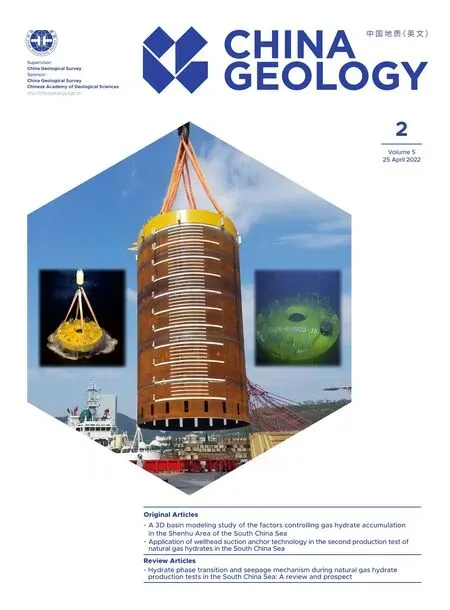Migration and accumulation characteristics of natural gas hydrates in the uplifts and their slope zones in the Qiongdongnan Basin, China
Yu-lin He , Jin-qiang Liang ,*, Zeng-gui Kuang , Wei Deng , Jin-feng Ren , Hong-fei Lai ,Miao-miao Meng , Wei Zhang
a Southern Marine Science and Engineering Guangdong Laboratory, Guangzhou 511458, China
b Guangzhou Marine Geological Survey, China Geological Survey, Ministry of Natural Resources, Guangzhou 510075, China
c National Engineering Research Center of Gas Hydrate Exploration and Development, Guangzhou 511458, China
Keywords:
Gas chimney
Overpressure
Migration characteristics of gas hydrates
Accumulation characteristics of gas hydrates
Oil and gas exploration engineering
NGHs exploration trial engineering
Uplifts and slope zones
Qiongdongnan Basin
China
A B S T R A C T
Various factors controlling the accumulation of natural gas hydrates (NGHs) form various enrichment and accumulation modes through organic combination.This study mainly analyzes the geological and geophysical characteristics of the NGHs occurrence in the uplifts and their slope zones within the deepwater area in the Qiongdongnan (QDN) Basin (also referred to as the study area).Furthermore, it investigates the dominant governing factors and models of NGHs migration and accumulation in the study area.The results are as follows.(1) The uplifts and their slope zones in the study area lie in the dominant pressure-relief direction of fluids in central hydrocarbon-rich sags in the area, which provide sufficient gas sources for the NGHs accumulation and enrichment through pathways such as gas chimneys and faults.(2) The top and flanks of gas chimneys below the bottom simulating reflectors (BSRs) show highamplitude seismic reflections and pronounced transverse charging of free gas, indicating the occurrence of a large amount of gas accumulation at the heights of the uplifts.(3) Chimneys, faults, and high-porosity and high-permeability strata, which connect the gas hydrate temperature-pressure stability zones (GHSZs)with thermogenic gas and biogenic gas, form the main hydrate migration system.(4) The reservoir system in the study area comprises sedimentary interlayers consisting of mass transport deposits (MTDs) and turbidites.In addition, the reservoir system has developed fissure- and pore-filling types of hydrates in the pathways.The above well-matched controlling factors of hydrate accumulation enable the uplifts and their slope zones in the study area to become the favorable targets of NGHs exploration.
1.Introduction
The natural gas hydrates (NGHs) are ice-like crystalline solids composed of water and methane gas.Since NGHs are important potential energy, countries worldwide have emphasized NGHs exploration and development and have seen significant achievements.For example, the USA conducted massive drilling in the Gulf of Mexico, verifying that hydrates have huge development potential (Ruppel C et al., 2008; Boswell R et al., 2009).Japan successfully obtained NGHs samples and carried out trial production of submarine hydrates in the Nankai Trough and the Sea of Japan (Moridis GJ et al., 2005).Countries such as South Korea, India, and Australia have also carried out the resource evaluation and development research of hydrates (Collett TS et al., 2006;Ryu BJ et al., 2009).In 2002, China formally launched its special national survey of NGHs resources and effectively completed two rounds of NGHs production tests in the Shenhu Area of the South China Sea in 2017 and 2020, which mark breakthroughs in the NGHs research in China (Li JF et al., 2018; Ye JL et al., 2020).
Previous studies have shown that the central depression zone in the Qiongdongnan (QDN) Basin is rich in source rocks and, thus, can provide high-quality source rocks for the accumulation of oil, gas, and NGHs (He JX et al., 2015; Lei ZY et al., 2016; Zhang W et al., 2018; Sun R et al., 2019;Zhou J et al., 2019).The uplifts and their pitching ends in the southern part of the QDN Basin are favorable areas for exploring large- and medium-sized oil and gas fields in the study area (Zhang GC et al., 2007).The central depression zone is characterized by overpressure, and the uplifts and their slope zones lie in the dominant direction of both pressure relief and deep-fluid diversion of the depression zone (Wang ZS et al., 2014).The results from hydrate drilling prove that the gas source types of shallow hydrates in the study area are closely related to deep oil and gas (Wei JG et al., 2019).Pathways such as gas chimneys/diapirs, faults, and shallow fractures are crucial to the migration and accumulation of hydrate gas (He JX et al., 2015).Moreover, numerous mass transport deposits (MTDs) have developed in the shallow strata in the study area.They block the diffusion of fluids below and may be an important factor determining the uneven distribution of hydrate reservoirs in the area (Wang XJ et al.,2011).
Previous studies on the hydrate accumulation in the QDN Basin primarily focus on gas sources, migration system, and hydrate accumulation conditions, while lacking the analysis of the driving forces of deep gas sources, the effects of uplifts on the hydrate accumulation, and the factors controlling the hydrate occurrence in various reservoirs.Therefore, this study ascertains the gas source characteristics, the migration characteristics of deep fluids, and factors controlling NGHs migration and accumulation in the study area mainly using seismic data combined with logging and coring data.Moreover, it analyzes the migration patterns of fluids and their effects on hydrate accumulation in the study area.The purpose is to provide references for exploring hydrate targets in this area.This study mainly aims to ascertain the following issues: (1) The migration mechanisms and their driving forces of deep thermogenic gas in the central hydrocarbon-rich depression and the uplifts and their slope zones in the study area; (2) the combination means by which deep faults, gas chimneys, and high-porosity and high-permeability strata form effective migration pathways to transport deep pyrolysis gas and shallow biogenetic gas into the gas hydrate temperature-pressure stability zones (GHSZs); (3) the geological factors that influence the formation of hydrates in various shallow reservoirs; (4) the matching mechanisms of various controlling factors of hydrate accumulation, which contribute to the formation of favorable NGHs exploration targets under the tectonic setting of the uplifts and their slope zones.
2.Geologic setting
The QDN Basin is a Cenozoic sedimentary basin located at the northern continental margin of the South China Sea.This basin, connecting the Xisha Islands and the Hainan Island in the NS direction and being sandwiched between the Pearl River Mouth and Yinggehai basins in the EW direction,generally extends in an arc shape along the southern boundary of Hainan Island (Zhu WL et al., 2009).Four first-order tectonic units have developed in this Basin, including the northern depression and central high in the shallow-water area and the central depression and southern high in the deep-water area (Fig.1).The second-order tectonic units in the basin include the Songnan Low Uplift, the Songnan-Baodao Sag,the Changchang Sag, the Beijiao Uplift, the Ledong Sag, the Lingshui Sag, the Lingnan Low Uplift, and the Beijiao Sag(Su M et al., 2014; Li C et al., 2017).

Fig.1.Tectonic unit division and seismic survey line distribution in the Qiongdongnan Basin.The black solid lines denote the locations of survey lines, the black dotted line represents the location of Fig.11, the red dotted box denotes the location of Fig.12.
The QDN Basin is a typical double-layer structure that is faulted in the lower part and is depressed in the upper part and has experienced three tectonic evolution stages, namely fault depression, depression, and neotectonic stages successively(Figs.2, 3; Li CF et al., 2014).During the Paleocene and Eocene, fault-depressed lacustrine basins were primarily deposited.During the Oligocene, the Yacheng and Lingshui formations were deposited and the sedimentary environment gradually changed from fault-depressed lacustrine basins to marine-continental transitional facies.The Paleogene and Neogene strata are bounded by interface T6, which also serves as the fault-depression transitional interface of the QDN Basin.In the Miocene, bathyal-abyssal deposits mainly developed, including the Sanya, Meishan, and Huangliu formations from old to young.During the Pliocene, the Yinggehai Formation was mainly deposited, and the continental slope and shelf system gradually took shape.The Neogene and Quaternary strata are bounded by interface T2 which is an important regional unconformity.The Ledong Formation had been deposited since the Quaternary.It is dominated by abyssal fine-grained argillaceous deposits, and numerous MTDs have been discovered there (Li CF et al.,2014; Liang JQ et al., 2019).

Fig.2.Comprehensive histogram of the geology in the Qiongdongnan Basin, China.

Fig.3.Seismic profile and interpretation of survey line A (its location is shown in Fig.1).HARS/ER: High-amplitude reflections/Enhance reflections.
The QDN Basin is an important oil and gas production area among the deep-water basins in the South China Sea.Three sets of source rocks have developed in this basin,namely high-quality Eocene lacustrine coal measures source rocks, Oligocene source rocks of littoral plains - littoralneritic facies, and Miocene bathyal-abyssal source rocks.The Oligocene source rocks mainly include the marine-continental transitional and neritic source rocks of the Yacheng Formation and marine mudstones of the Lingshui Formation,which are secondary source rocks.The Miocene bathyalabyssal source rocks are also secondary source rocks, and most of them are immature - lowly mature (Zhu WL et al.,2009; Liang JQ et al., 2019).Through comparative analysis of gas isotopes, Zhu WL et al.(2009) found that the gases in shallow NGHs reservoirs in the study area mainly originate from the coal measures source rocks of the Eocene-Oligocene Yacheng Formation.Hydrates in the study area mainly occur in the Songnan and Lingnan low uplifts and the Lingshui and Baodao sags (Wang XJ et al., 2021).In 2015, the Guangzhou Marine Geological Survey, China Geological Survey discovered the Haima cold seep and obtained hydrate samples in the QDN Basin for the first time.Moreover, it obtained hydrate samples at multiple sites during the hydrate drilling expeditions in 2018 and 2019 (Wei JG et al., 2019; Wang XJ et al., 2021).These findings indicate that the QDN Basin has huge potential for hydrate resources.
3.Occurrence characteristics of NGHs
In recent years, the Guangzhou Marine Geological Survey, China Geological Survey has carried out a series of hydrate drilling activities in the study area.The logging while drilling (LWD) at 12 sites revealed the logging anomalies that indicate NGHs occurrence, and visible hydrate samples were obtained through coring at four of the 12 sites.These findings verify that pore- and fissure-filling types of NGHs have developed in the study area (Figs.4, 5; Liang JQ et al., 2019;Wei JG et al., 2019; Ye J et al., 2019).Two sets of hydrate reservoirs have been discovered during the drilling at site W01, which are 38 m thick at a depth of 5.2-43.2 mbsf and 66 m thick at a depth of 52.2-118.2 mbsf each.They mainly include massive and lamellar hydrates, and sandy reservoirs with the pore-filling type of invisible hydrates have developed at a depth of 56-64 mbsf (Fig.4).Three sets of hydrate reservoirs have been discovered during the drilling at site W08, which have a thickness of 9.0 m, 30.8 m, and 120.8 m each and mainly consist of massive and veined hydrates (Fig.5).The hydrates in the study area mainly have the following distribution characteristics.(1) The coexistence of fissure- and pore-filling types of hydrates.The fissure-filling type of hydrates are mainly massive and lamellar in shape and have a maximum resistivity of 250 Ωm, noticeable sonic logging anomalies, and high calculated saturation.By contrast, the pore-filling types of hydrates mainly occur in coarse-grained sandy turbidites.They have a small thickness and high saturation and showed distinct temperature anomalies during field tests of cores.(2) Thick hydrates occur in the leakage vents and show multi-layer distribution.The hydrate reservoirs are mainly composed of multiple sets of interlayers consisting of MTDs and turbidites.(3) All the hydrate samples were obtained during the drilling in the leakage vents.The logging and seismic comparison revealed that thinlaminated strong seismic reflection axes have developed above bottom simulating reflectors (BSRs), indicating that thin-laminated sandy hydrate reservoirs may have developed at the bottom of the reservoirs.
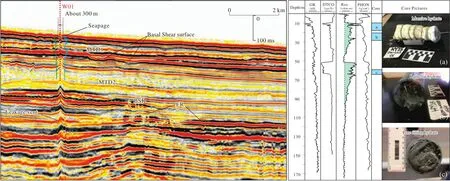
Fig.4.Seismic, logging, and core characteristics of site W01 in the Qiongdongnan Basin, China.ER-Enhance reflections.a-the massive hydrate core location.b-the lamellar hydrate core location.c-the pore filling hydrate core location.
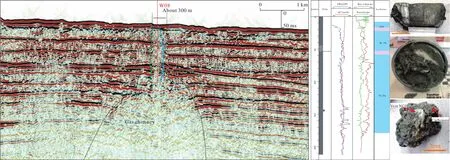
Fig.5.Seismic, logging, and core characteristics of site W08 in the Qiongdongnan Basin, China.ER-Enhance reflections.
4.NGHs-related seismic characteristics
Five types of seismic response characteristics indicative of the existence of gas hydrates have been identified in the uplifts and their slope zones in the study area through the analysis of multichannel seismic data.They mainly include BSRs, gas chimneys and their fuzzy reflections of gas inside,high-amplitude reflections in the GHSZs, strong reflections below BSRs, and leakage vents and seafloor outcrops.
4.1.Bottom simulating reflectors (BSRs)
A BSR refers to a reversed polarity seismic reflection interface that spreads nearly parallel to the seafloor on a seismic profile.It usually forms by the differences in wave impedance between hydrate-bearing sediments and their underlying strata, which are usually free gas-bearing zones(Haacke RR et al., 2007).Therefore, a BSR generally indicates the bottom interface of a GHSZ.The interpretation of the seismic profiles of the study area reveals that the BSRs in the study area mainly have the following characteristics(Figs.6b, 7b, 8b).(1) All the BSRs develop in Quaternary sedimentary strata, and most of them develop at the top of gas chimneys; (2) low-frequency or strong seismic reflections ubiquitously develop below the BSRs, indicating the accumulation of free gas below the BSRs; (3) partial BSRs are truncated by the overburden, indicating local fluid leakage; (4) since the study area is in a deep-water plain, the BSRs in the study area are almost parallel to the seafloor and hardly obliquely intersects with sedimentary strata.Therefore,most BSRs do not show noticeable seismic responses; (5)BSRs mainly develop at the structural heights and on the slopes of uplifts, which is strongly consistent with the distribution of gas chimneys.The BSRs in the study area have a burial depth of 130-170 m.
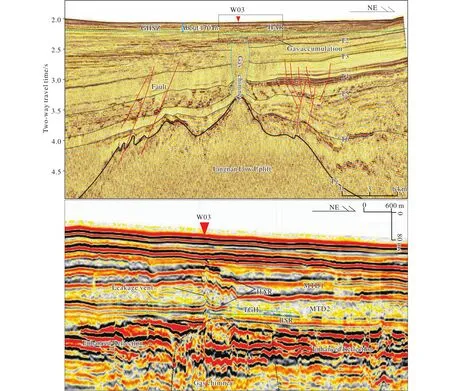
Fig.6.Interpretation of the reflection characteristics of a seismic profile at site W03 (its location is shown in Fig.1).HARS/ER-high-amplitude reflections/Enhance reflections.TGH-top of gas hydrate.
4.2.Gas chimneys and their fuzzy reflections of gas inside
Gas chimneys usually show cylinder-shaped seismic reflection anomaly zones or chaotic reflections, which indicate fluid migration or even leakage (Berndt C et al.,2005; Sun Q et al., 2013).Similar to the BSRs in the study area, gas chimneys in the area are also mainly distributed on structural heights and slopes (Figs.6a, 7a, 8a).Many gas chimneys with fuzzy reflection zones have been identified in the study area.They have an average planar diameter of about 5-6 km each and develop vertically from the Late Eocene to Quaternary strata, with the top mostly penetrating Quaternary MTDs.The bottom of a gas chimney is mainly identified by its seismic reflection axis disappearing or becoming fuzzy reflections.According to the analysis of seismic profiles, the roots of the gas chimneys in the study area all develop above the Late Oligocene strata (T6) and are observed to have truncated the seismic reflections of strata.The Late Oligocene(T6) is the tectonic evolution period when the QDN Basin transitioned from the fault depression stage to the depression stage, indicating that the tectonic evolution of the QDN Basin is crucial to the formation of gas chimneys in the study area(Zhang GC et al., 2007; He JX et al., 2015).The gas chimneys show distinct seismic reflection anomaly zones and strata pull-down inside.Moreover, their edges show bright spots of high-amplitude seismic reflections, which are inferred to result from the difference in wave impedance between their edges and their top and bottom strata induced by the transverse charging of gas.High-amplitude seismic reflections occur at the top and flanks of the gas chimneys.They are inferred to be caused by the charging of free gas.In the study area, gas is mainly carried into GHSZs by gas chimneys to form hydrates.Fluids are observed leaking into shallower layers in local weak strata.
4.3.High-amplitude seismic reflections within GHSZs
High-amplitude seismic reflections are commonly visible at the top of gas chimneys in the study area (Figs.6b, 7b, 8b).They are often distributed above BSRs and are limited by the distribution of MTDs.They reflect the changes in seismic properties caused by different hydrate saturation values, gas saturation values, and other fluid contents of sedimentary strata (Ma ZT et al., 2000).When a large amount of gas reaches GHSZs through gas chimneys, hydrate reservoirs will be formed under sufficient hydrocarbon gases and water.The phase transformation from the liquid and gas phases to the solid phase enhances the velocity of seismic waves and seismic reflection amplitude, making the seismic reflection axes change accordingly (Ma ZT et al., 2000).When seismic waves enter hydrate-bearing strata from ordinary strata, they will show positive polarity seismic reflections (Zhang GX et al., 2003).
Fig.7b and Fig.8b show that high-amplitude seismic reflections also exist in shallow strata.They mainly occur in shallow leakage vents and are vertically overlapped with each other along with the vents.Strata close to the seafloor show distinct polarity inversion and hillock reflections.In addition,their seismic reflections show polarity inversion relative to those of their surrounding strata.As verified by drilling,logging, and coring, such strata with high-amplitude seismic reflections are the responses of carbonate sediments.

Fig.7.Interpretation of reflection characteristics of a seismic profile at site W08 (its location is shown in Fig.1).HARS/ER-high-amplitude reflections/Enhance reflections.TGH-top of gas hydrate.

Fig.8.Interpretation of reflection characteristics of a seismic profile at site HM (its location is shown in Fig.1).HARS/ER-high-amplitude reflections/Enhance reflections.TGH-top of gas hydrate.HM-haima seepage.
4.4.High-amplitude seismic reflections below BSRs
High-amplitude and low-frequency seismic reflections have been identified below the BSRs at the top of gas chimneys in the study area (Figs.6b, 8b).They widely occur on the flanks of gas chimneys and their fuzzy reflection zones of gas inside and have strong amplitude and low frequencies,which are even more significant than the response of the BSRs.Such high-amplitude reflections below the BSRs are generally considered to be induced as follows.When migrating to the shallow strata along with gas chimneys, gas is blocked by hydrate layers or dense sedimentary layers and then migrates transversely.As a result, a large amount of gas accumulates at the top of the dome-shaped gas chimneys,inducting large wave impedance differences between the top of the gas chimneys and its surrounding rocks.Such wave impedance differences are usually present as patch-shaped high seismic amplitude in shallow parts on the seismic profile(Gay A et al., 2009; Horozal S et al., 2009).In addition, the high-amplitude reflections below the BSRs are also related to the phenomenon that strata above block the vertical gas channel system.Such blockage induces transverse gas charging.The strata in the lower part of MTDs is dense due to sliding stress (Wang XJ et al., 2021, 2011), leading to wave impedance differences similar to those of hydrate-saturated strata.Therefore, high-amplitude reflections occur at the top of the gas chimneys rather than the bottom interfaces of BSRs on the seismic profile.This is also why it is difficult to identify the BSR interfaces at multiple positions.As Fig.6b shows, the bottom interfaces of BSRs calibrated by logging do not show significant seismic responses, while the vicinity of gas chimneys below BSRs shows distinct low-frequency and high-amplitude seismic reflections.The gas charginginduced high-amplitude reflection layers below the BSRs are more developed than the seismic reflection layers above the BSRs that reflect the transverse distribution of hydrates.This phenomenon indicates that the hydrate layers in the leakage vents in the GHSZs and the dense strata below the MTDs form a relatively effective rock cap for the vertical gas migration (Wang XJ et al., 2011).
4.5.Leakage vents and seafloor outcrops
Many superficial leakage vents have been identified in the study area through the analysis of seismic profiles.Moreover,many highly saturated hydrate samples have been obtained in these leakage vents through drilling (Liang JQ et al., 2019;Wei JG et al., 2019; Ye J et al., 2019).Shallow leakage vents have been identified in many hydrate-rich sea areas around the world, and it has been verified that hydrates develop in these vents (Crutchley GJ et al., 2010; Yoo D G et al., 2013).As seismic profiles show, the leakage vents in the study area develop in small ranges in shallow parts, with a diameter of about 100-300 m and a burial depth of about 100-200 m each(Figs.4, 5).They are in the shape of long flat bands on the seismic profile, and their internal seismic reflections are characterized by blank and chaotic reflections and pull-ups.They mainly develop at the top of the gas chimneys at relatively structural heights and serve as ideal relay channels for vertical fluid migration.Their roots connect the strong seismic reflection axes at the top of gas chimneys and above the BSRs, and their tops mainly penetrate multiphase MTDs and even form mounds with reversed polarity at the seafloor.As verified by surveys, the seismic polarity inversion at the seafloor formed by leakage vents is the response of carbonate sediments.
After migrating to GHSZs through leakage vents, highflux hydrocarbon gases form pore- and fissure-filling types of hydrates in shallow sediments (Figs.4, 5).As the leakage continues, high-temperature fluids that arrive through gas chimneys make hydrates in the leakage vents unstable, which then constantly decompose and form (Chen DF et al., 2005a).The methane gas resulting from hydrate decomposition migrates to the seafloor through leakage vents, thus providing a material basis for the biocenosis in cold seeps (Chen DF et al., 2005b).Large-scale outcrops of active cold seeps were discovered at the seafloor at sites W01 and Haima (HM),including a host of organisms in cold seeps (e.g., active mussels, shrimps, and crabs) and authigenic carbonate rocks.Moreover, massive hydrate samples were collected in the field at these two sites (Fig.9).In addition, these outcrops show significant polarity inversion on seismic profiles (Figs 4, 8).These phenomena indicate the occurrence of large-scale methane leakage at these two sites, which leads to the formation of authigenic carbonate deposits and the development of chemoautotrophic biocenosis near the seafloor.
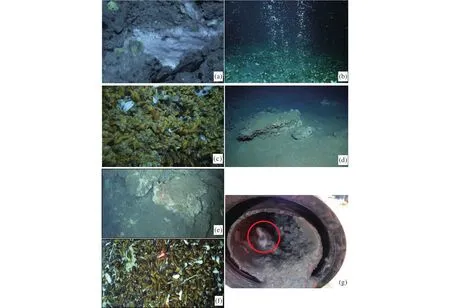
Fig.9.Outcrops of active cold seeps in the Qiongdongnan Basin.a-gas hydrate sample at site W01; b-vents of active cold seeps at site W01;c-mussels at site W01; d-carbonate rocks at site W01; e-carbonate rocks at site HM; f-gas hydrate samples at site HM; g-mussels at site HM(modified from Liang QY al., 2017; Zhao J al., 2020).
5.Discussion
5.1.Effects of peripheral hydrocarbon-rich sags on gas source supply of NGHs reservoirs
5.1.1.Gassourcesandtypesofhydrates
As shown by the test and analysis results of gas samples(headspace gas, pore gas, and gas associated with the pressure relief of pressure cores) obtained from hydrate drilling in the study area, the samples of site W08 have methane and ethane contents of 72.5%-97.5% and 1.9%-12.1%, respectively.Meanwhile, hydrocarbon components, such as propane, nbutane, and isobutane, have also been detected in most gas samples.The sample tests show that theδ13C values of methane, ethane, and propane at this site are ?63.6 ‰ -?51.9 ‰, ?29.2 ‰ - ?26.6 ‰, and ?25.6 ‰ - ?23.7 ‰,respectively (Lai HF et al., 2021).These results indicate that biogenetic gas and especially thermogenic gas are the primary gas sources of hydrates in the study area (Fig.10).
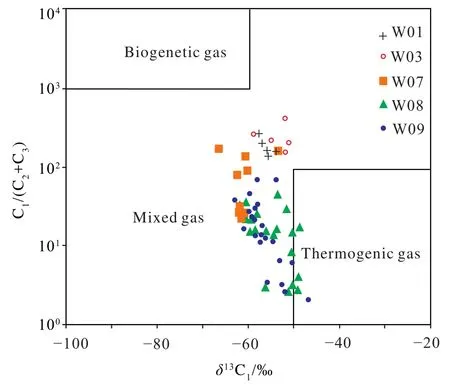
Fig.10.Genetic analysis of gas sources of hydrates in the uplifts and their slope zones in the Qiongdongnan Basin.
The NGHs in the study area can be grouped into two types according to their gas sources: one type whose gas sources mainly include biogenic gas in shallow strata and the other type whose gas sources mainly include thermogenic gas in deep strata.The hydrates of the former type form as follows.The study area lies on the slopes in the southern part of the central depression zone.The shallow strata in the study area have widely developed bathyal deposits and thus have highcontent organic matter, which produces methane via biogenetic action under certain conditions.Later, the biogenic gas enters GHSZs to form mixed NGHs reservoirs after diffusing in high-porosity and high-permeability sedimentary strata or migrating along with the shallow fracture system.The hydrates of the latter type from as follows.The study area lies on the slopes in the southern part of the central depression zone and is immediately adjacent to hydrocarbon-rich sags,such as the Ledong-Lingshui, Songnan-Baodao, and Ganquan-Beijiao sags.Most significantly, the Eocene-Oligocene coal measures source rocks in the Ledong-Lingshui Sag are the main thermogenic gas source of adjacent oil and gas reservoirs (Li WH et al., 2011).Neogene coal measures strata are primarily under a high-temperature and high-pressure environment, which provides a favorable geological condition for the formation of thermogenic gas.The study area has well-developed faults and gas chimneys,through which deep thermogenic gas can migrate to the shallow part of strata to form hydrates under suitable temperature and pressure conditions.
5.1.2.Drivingforceforthemigrationofdeepthermogenic gas
The QDN Basin features abnormally high temperature and overpressure (Zhu JJ et al., 2011), especially in the central depression zone, where the geothermal gradient is up to 102-111°C/km due to magmatic intrusion (Lai HF et al.,2021).The overpressure in the central depression zone mainly occurs in the Meishan Formation and strata below (Zhu JJ et al., 2011).The Paleogene and Neogene overpressure in the central depression zone was formed late.Among them, the Paleogene overpressure resulted from the rapid deposition of the Meishan Formation, as well as the maturation,hydrocarbon generation, and hydrocarbon cracking of source rocks induced by the high geothermal gradient.By contrast,the Neogene overpressure was mainly caused by compaction(Zhu GH et al., 2000).Numerous neritic-bathyal mudstones deposited in the Late Miocene Huangliu Formation and the Pliocene Yinggehai Formation provide ideal cap rocks for the formation of the overpressure environment below these two formations.As the pressure coefficient distribution profile of the study area shows, intense overpressure is mainly distributed in the Meishan and Sanya formations in the Yongle-Lingshui Sag and strata below these formations, and the pressure coefficient gradually decreases toward the uplift area in the southern part.Moreover, since most faults and gas chimneys in the uplifts and their slope zones have relatively low-pressure coefficients (Fig.11), deep gas can release pressure to shallow layers through these faults and gas chimneys.It can also be seen from the profile that the Lingnan and Songnan low uplifts and their surrounding areas lie in the transitional zone of the overpressure in the central depression zone.In addition, these two low uplifts are the relief zones of deep overpressure in the sags and the only migration path of hydrocarbon gases produced by the deep source rocks in the central depression zone.Therefore, the low uplifts and their slope zones lie in the dominant direction to relieve the overpressure in the central depression zone, as verified by the concentrated development of gas chimneys and active cold seeps in the uplift areas in the southern part of the study (Fig.12).As the tectonic transform zone in the QDN Basin, the uplift areas in the southern part have a series of developed EW-strike faults (such as Nos.11 and 13 faults)and derived faults, which are pathways for deep fluids to migrate (Figs.1, 11).In addition, the subsidence rate varied with tectonic positions in the QDN Basin at the late stage,resulting in different compaction degrees of the overlying strata.Hugely thick strata were deposited in the central depression zone at the late stage due to abundant provenance,while the sedimentary strata are thinner in the low uplift areas(Zhang GC et al., 2007; He JX et al., 2015; Li WH et al.,2011; Zhou J et al., 2019).The resulting regionally different compaction further makes the uplift areas that bear low formation pressure become the dominant pressure-relief destinations of deep overpressure fluids.
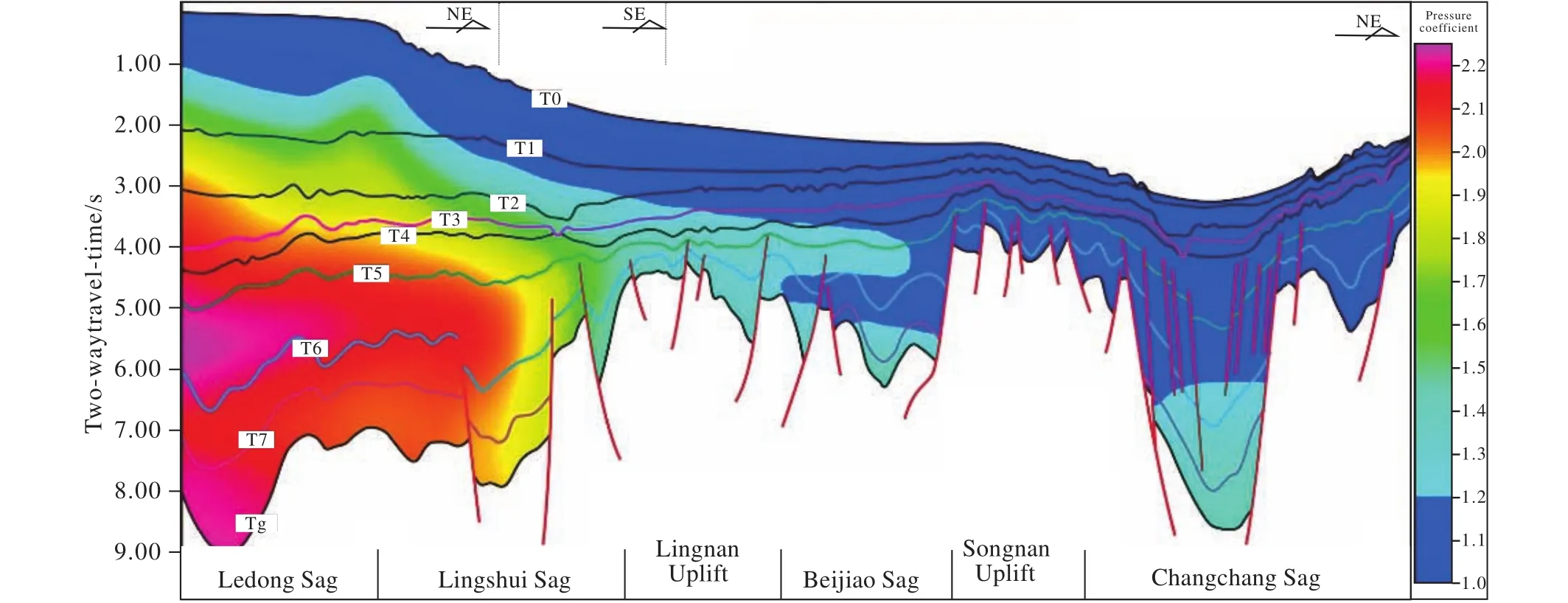
Fig.11.Vertical distribution of pressure coefficients in the central depression zone in the Qiongdongnan Basin (modified from Wang ZH et al., 2014).
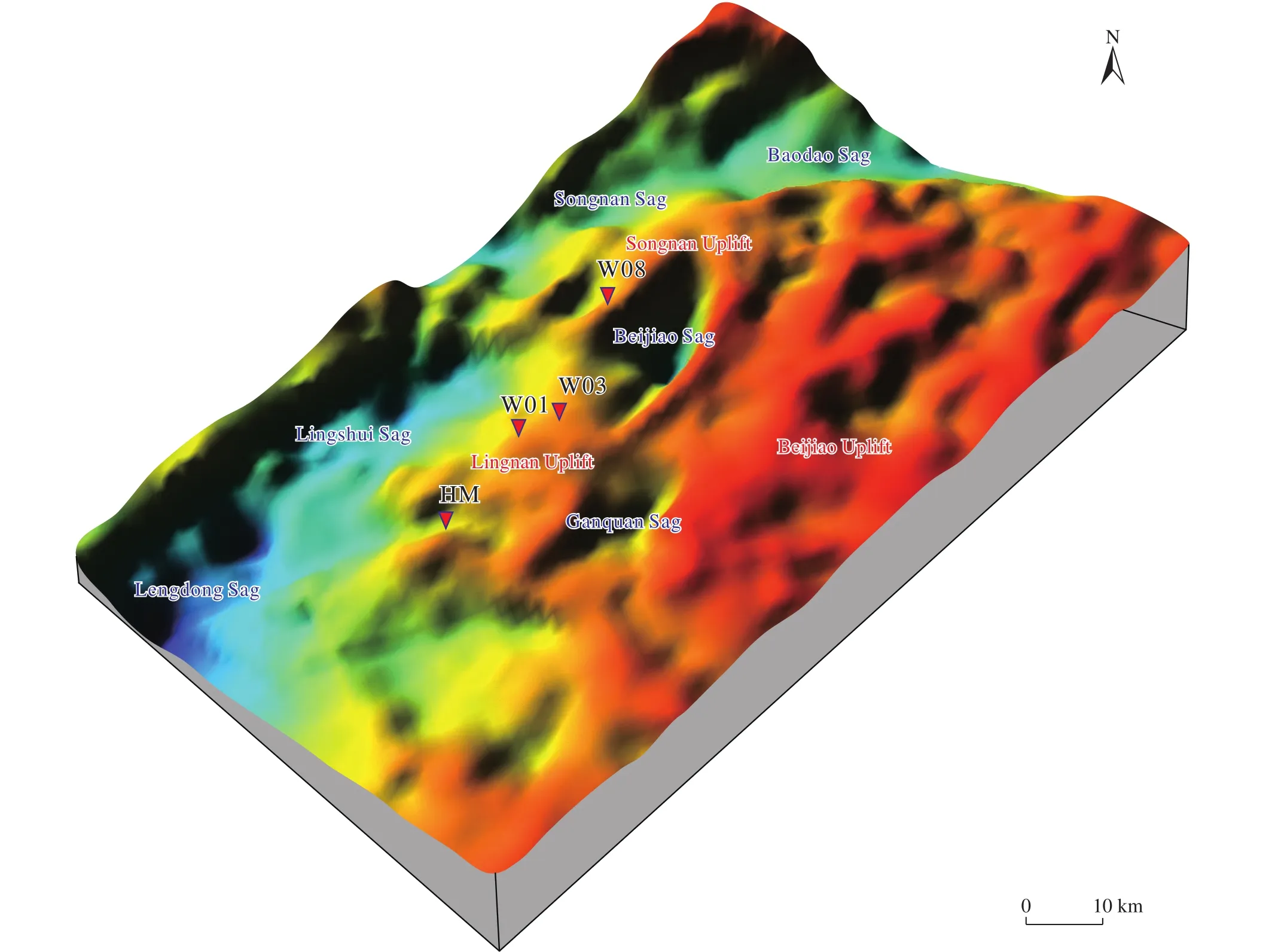
Fig.12.Map showing the distribution of uplifts in the Qiongdongnan Basin (their locations are shown in Fig.1).
5.2.Migration mechanisms of gas into GHSZs
As discussed above, gas sources of NGHs in the study area are dominated by thermogenic gas, which mainly originates from the source rocks in the Eocene-Oligocene coal measures adjacent to hydrocarbon-rich sags.The deep gas sources in abyssal sediments usually migrate to GHSZs via pathways that fluids can easily unchoke.Moreover, it is common for multiple types of pathways (i.e., faults, fissures,diapirs, and other high-permeability pathways) to combine into one or more effective migration pathways (Wan Z et al.,2017; Zhang W et al., 2020).Two types of migration pathways of NGHs gas sources have been identified in the study area from seismic profiles.The first type is structural pathways, including faults and gas chimneys, while the second type is high-porosity and high-permeability sedimentary strata.
5.2.1.Verticalmigrationthroughfaultscombinedwithgas chimneys
The rapid subsidence of the QDN Basin during the Oligocene led to the development of numerous faults, which,together with the gas chimneys developing above uplifts, form the main gas migration pathways.It is well known that fluids tend to leak into low-pressure areas when migrating (Xie XN et al., 2004).The study area is located at the structural heights of the uplifts adjacent to the edges of overpressure sags and thus lies in a dominant direction of deep fluid diffusion.Moreover, since the rapid rifting stage of the QDN basin during the Oligocene, the sedimentary strata in the study area are the thickest in the central depression zone and are increasingly thin toward the peripheral uplifts and their slope zones (Zhu WL et al., 2007; Zhou J et al., 2019).Owing to the different thicknesses of overlying strata, the northern and southern ends of the structural heights of the uplifts form a seesaw structure.The pressure of the overlying strata is high in the central depression zone due to thick strata but is low at the heights of the uplifts.Deep gas requires high driving forces of fluids to break through high formation pressure and can relatively easily break through the thin overlying strata of the uplifts.Therefore, driven by overpressure fluids, the deep gas in the depression zone (such as the Lingshui Sag) breaks through the overlying strata at structural heights such as uplifts and their slope zones.As a result, gas chimneys form,which allow deep thermogenic gas to continue to diffuse into shallow strata.In addition, due to the different compaction induced by different thicknesses of strata, small faults can develop along the structural transition zone at the depression margin and structural heights.These small faults further promote the vertical migration of gas and the formation of gas chimneys.Moreover, these faults will be activated again when they are charged with fluids.The interactions between fluids and faults contribute to the formation of gas chimneys distributed along the structural heights.These gas chimneys serve as the primary routes by which deep gas leaks into shallow strata in the study area.
5.2.2.Transversemigrationthroughhigh-porosityand permeability-sedimentarystrata
The dominant pressure-relief pathways in the study area are the high-porosity and high-permeability sedimentary strata that have developed since the formation of the Miocene Sanya Formation.They connect gas chimneys developing in the uplifts and become an important migration means of gas.They mainly include unconformities, boundaries of canyons and channels, and sandy sedimentary strata with high connectivity (Xu LT et al., 2021).The Sanya Formation in the southern QDN Basin mainly consists of coastal and neritic deposits, where slope fans, basin-floor fans, and low-stand deltas have developed.The Meishan and Huangliu formations have developed neritic fan-delta deposits and deep-water sandy turbidites (Zhu WL et al., 2007).In addition, apparent unconformities developed in the study area during the Late Miocene (T4) and the Late Pliocene.These high-porosity sedimentary strata serve as pathways for deep fluids to transversely migrate.Driven by the overpressure in the central depression zone, deep fluids are transported to the lowpressure areas in the southern uplifts along these highporosity sedimentary strata.Afterward, they are transported to shallow strata by the gas chimneys at the heights of the uplifts, thus providing gas sources for the hydrate reservoirs.
5.3.Factors controlling the accumulation of shallow NGHs
As drilling and coring verify, pore- and fissure-filling types of NGHs have developed in the study area (Figs.4, 5).The formation of their reservoirs is closely related to shallow leakage vents and MTDs.
5.3.1.Reservoirsoffissure-fillingtypeofNGHs
Many superficial leakage vents have been identified at the top of gas chimneys in the study area.Moreover, many highly saturated hydrate samples were obtained from these vents during early drilling.They are mainly massive, lamellar,veined in shape and are the fissure-filling type of hydrates,which are usually distributed in a small range similar to the size of the leakage vents.However, they are thick vertically,with a thickness of up to 114 m, 160 m, and 94.3 m,respectively at sites W01, W08, and W03.Seismic profiles show strata pull-down in the leakage vents, which is inferred to be caused by the increasing seismic velocity resulting from hydrate occurrence.All these leakage vents develop at the structural heights of the uplifts and their slope zones (Figs.3,13, 14).Affected by the “seesaw” structure of the structural heights, the overlying strata are liable to form small faults in shallow parts.Moreover, the gas in gas chimneys continues to leak into the seafloor through these small faults, further promoting the development of these small faults.Therefore,the widely developed leakage vents in the study area result from the tectonic effects caused by the combined action of vertical fluid leakage and different sediment compaction.The size of shallow leakage vents in the study area limits the distribution range of fissure-filling type of hydrates in the study area.
5.3.2.Reservoirsofpore-fillingtypeofhydrates

Fig.13.Seismic profile of survey line B and its interpretation (the location is shown in Fig.1).ER-Enhance reflections.
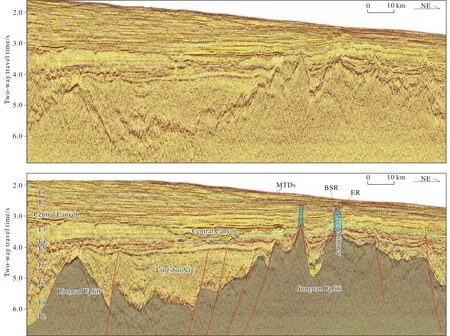
Fig.14.Seismic profile of survey line C and its interpretation (the location is shown in Fig.1).ER-Enhance reflections.
The GHSZs in the study area have developed interbeds consisting of MTDs and turbidites.In the process of gas diffusion, the coarse-grained thin-laminated turbidites rather than MTDs serve as the dominant pathways for fluid diffusion.The section with low gamma-ray values within the depth of 56-64 mbsf at site W01 contains the pore-filling type of hydrates (Fig.4).As the seismic profile shows, this section corresponds to a set of thin turbidite layers in the lower part of MTD1, shows high-amplitude reflections, and appears to have been eroded by MTDs.Meanwhile, the shear layers at the bottom interface of the MTD act as the transverse diffusion channels of gas.When multiphase MTDs develop in the superficial strata, gas is more difficult to vertically leak but is more liable to transversely diffuse.Therefore, the transverse charging of gas occurs at the bottom interface of MTDs.In this case, the diffusion type of hydrate layers forms under appropriate temperature and pressure conditions (Sun Q et al.,2017).In addition, whether the gas that transversely charges in the lower part of the MTDs can form hydrates also depends on GHSZs in the study area.As determined by loggingseismic calibration, GHSZs occur in the study area, with the bottom interface having a burial depth of 130-170 m.The hydrate layers of diffusion type have been identified above the BSRs and below the MTDs, and their thicknesses are restricted by the distribution of MTDs and thin turbidite layers in the study area.
5.4.NGHs accumulation model
Similar to conventional oil and gas, the NGHs accumulation also involves gas sources, migration, and reservoir formation (Qiao SH et al., 2013; Yang SQ et al.,2017).Based on analysis of the migration and accumulation characteristics of NGHs in the uplifts and their slope zones in the study area, this study established the migration and accumulation model of NGHs in the study area by considering the factors such as gas source system, the driving force of migration, migration pathways of fluids, and hydrate accumulation characteristics within GHSZs, as well as the spatial-temporal matching relationships between these factors(Fig.15).
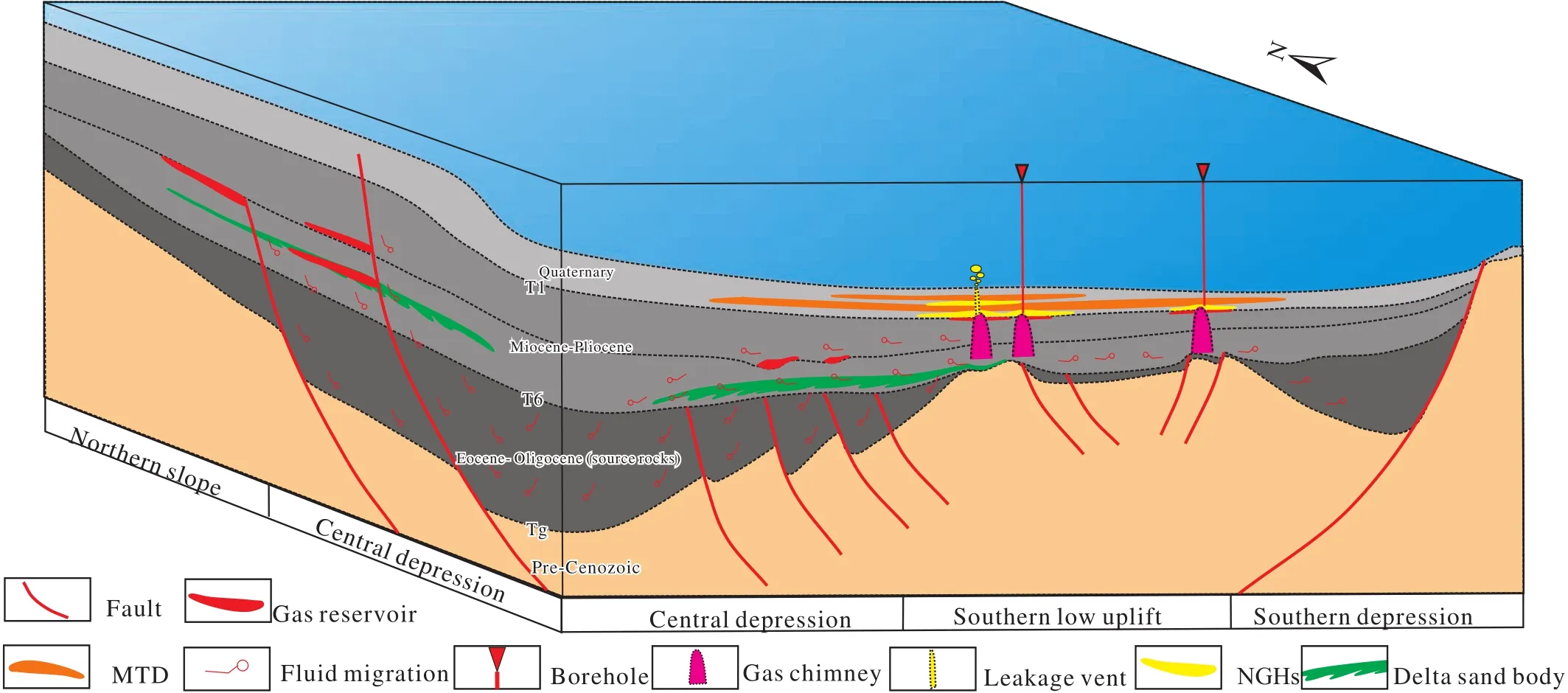
Fig.15.NGHs migration and accumulation model in the uplifts and their slope zones in the Qiongdongnan Basin.
As the test and analysis results show, the gas sources of NGHs in the study area include thermogenic gas primarily and biogenetic gas secondarily.The study area is located at the structural heights of the hydrocarbon-rich sags on the south slope of the central depression zone.It thus has an excellent background for the formation of thermogenic gas.Moreover, the study area is in the dominant overpressurerelief direction of the central depression zone.This overpressure background provides the driving force for the migration of deep thermogenic gas.The faults at the depression margins that develop in the rapid rifting stage of the QDN Basin during the Oligocene act as pressure-relief pathways of deep overpressure fluids.High-porosity and high-permeability sedimentary strata have developed in the Sanya, Meishan, and Huangliu formations since the Miocene.They serve as the key channels for the transverse migration and accumulation of deep thermogenic gas and shallow biogenic gas, which are finally transported to shallow GHSZs by the gas chimneys at the structural heights of the uplifts to form NGHs reservoirs.
The study area is located at the heights of the low uplifts in the central depression zone of the QDN Basin.The different thicknesses of the overlying sedimentary strata in the study area lead to the development of small faults in the superficial strata, which act as the leakage vents of gas.When the methane gas in gas chimneys relieves pressure to shallow strata, the methane gas filled in the leakage vents forms a fissure-filling type of hydrates.The GHSZs in the study area have developed interlayers consisting of multiphase MTDs and turbidites.During pressure relief, most of the methane gas is blocked by multiphase MTDs and hydrates in the leakage vents.As a result, the gas transversely diffuses along with the coarse-grained turbidite layers or the shear layers at the bottom of MTDs, forming the pore-filling type of hydrates.Therefore, there are various NGHs reservoirs in the study area are.The NGHs migration and accumulation model of the uplifts and their slope zones in the study area that was established based on the above research will provide references for NGHs exploration in the periphery of the hydrocarbon-rich depression and the uplifts and their slope zones in the study area.
6.Conclusions
(i) Seismic response characteristics indicative of the occurrence of gas hydrates have been identified in the uplifts and their slope zones in the study area, mainly including BSRs, gas chimneys and their fuzzy reflections of gas inside,high-amplitude reflections in the GHSZs, strong reflections below BSRs, and leakage vents and seafloor outcrops.
(ii) The gas sources of NGHs in the study area mainly include mixed gas dominated by thermogenic gas.The coal measures source rocks in the central hydrocarbon-rich sags in the study area provide a material basis for hydrate accumulation.Moreover, the uplifts and their slope zones in the southern part of the study area lie in the dominant pressure-relief direction of fluids in the overpressure sags.This overpressure background provides the driving forces for the migration of deep fluids.
(iii) The faults in the periphery of the uplifts developing in the rapid rifting period of the QDN Basin act as deep pressure-relief channels of overpressure fluids.The gas chimneys at the heights of the uplifts transport the deep thermogenic gas and biogenic gas to shallow GHSZs to form NGHs.
(iv) The uplifts and their slope zones in the study area have favorable NGHs accumulation factors, including the supply system of deep gas sources, driving forces for migration, a migration system dominated by gas chimneys,and the hydrate accumulation system in the GHSZs, as well as favorable temporal-spatial matching relationships of these factors.All these factors jointly control the NGHs migration and accumulation model, indicating that the uplifts and their slope zones in the study area are favorable targets of NGHs exploration.
CRrediT authorship contribution statement
Yu-lin He and Jin-qiang Liang conceived of the presented idea.Yu-lin He, Jin-qiang Liang, Zeng-gui Kuang, and Wei Deng carried out the seismic interpretation.All authors discussed the results and contributed to the final manuscript.
Declaration of competing interest
The authors declare no conflicts of interest.
Acknowledgment
This study was funded by the projects initiated by the China Geological Survey (DD20190217 and DD20190230),the key special project for introduced talent team of Southern Marine Science and Engineering Guangdong Laboratory(Guangzhou) (GML2019ZD0102), and Guangdong Major project of Basic and Applied Basic Research(2020B0301030003).
- China Geology的其它文章
- Exploring natural gas hydrates toward a carbon-neutral world
- Hydrate phase transition and seepage mechanism during natural gas hydrates production tests in the South China Sea: A review and prospect
- A 3D basin modeling study of the factors controlling gas hydrate accumulation in the Shenhu Area of the South China Sea
- Application of frequency division inversion in the prediction of heterogeneous natural gas hydrates reservoirs in the Shenhu Area, South China Sea
- Velocity-porosity relationships in hydrate-bearing sediments measured from pressure cores, Shenhu Area, South China Sea
- Experimental study on characteristics of pore water conversion during methane hydrates formation in unsaturated sand

